
H
S
Edgworth
&
District Horticultural
Society
New
Time of 7.00
pm
Wednesday,
February 17th, 2021 by Zoom
FORAGING
THROUGH THE SEASONS
An
illustrated talk by
Marlow
Renton - Foraging
expert,
Teacher
and co-Founder of Wildfood UK Ltd.
Wildfood
UK Ltd was started with the aim
of educating people to appreciate what nature provides in the form of
tasty
edible wild plants, fruits, mushrooms, roots and flowers. Over the
years, the
team of instructors has grown and offers popular foraging experiences
countrywide where you can learn what to look for, where to find it, how
to eat it
and store it.
Marlow
is a member of the Association of
Foragers and with his friend Eric Biggane has written an invaluable
field guide
to foraging for food in Britain’s woods, meadows, trees
riversides and seaside
– the Foraging Pocket Guide.
During
his talk, he will certainly be
telling us all about his passion for mushrooms - which can be
found all
over the country but in abundance in the autumn.
After
not being able to meet for almost
all of 2020, the Society has been motivated to organise meetings using
Zoom
technology until we can once again resume our meetings at The
Barlow.
This should be a very interesting talk and for those of you who joined
us for
our first ever Zoom meeting in January, I am sure you will enjoy
Marlow’s talk
every bit as much.
Pat Whalley
>>>>>>>>>>
January
saw our first attempt to hold our meeting for members via
Zoom. We have
held regular Zoom committee meetings since March 2020 as I
have mentioned
before, but hosting a live presentation with an audience could go
horribly
wrong without careful preparation. With the committee as the audience,
we held
practice sessions with our speakers. These were invaluable and also
helped to
make the event less stressful for all who were directly involved.
Presenting
to a laptop camera was a new experience for Geoff and
Margaret Fletcher. They did a fantastic job telling us about the
history of the
NGS and showing photos of NGS gardens in our area.
Can’t wait to start
visiting again.
The
event seemed to go very well and lots of you have expressed very
positive
comments, so we have decided to continue in this way, wherever
possible, until
we are able to meet at tha Barlow . Of course not all the
speakers may be
able to oblige in this way so there will possibly be some changes to
the
programme below but you will be given any updated details on a monthly
basis.
Some
members
hoped
to join us in January but didn’t make
it. If
the reason was a problem with logging on please let us know as we may
be able
to help.
If
you want to join us on Zoom for this talk about Foraging on 17th
February it is important that you let me know as soon as you can.
I
will send the joining details to you a few days in advance of the
talk.
e-mail
- secretary@edgworth-horticultural-society.co.uk
We
have
2 articles this month about garden visits by 2 of our members, Angela
is our
Membership Secretary and Carole is our long distance member who lives
in London
so whilst we are using Zoom she is able to join us. It is
good to see the
north and south coming together. It is Carole we have to thank for our
4-day
holidays as she introduced us to the idea originally and has joined us on
almost every
holiday since.
It
would seem that a lot is happening at
Kew Gardens with many early signs of spring. We have to wait
a little
while longer here for the spring bulbs to flower in our local gardens
but that
is something to look forward to. I do have a hellebore coming into
flower in my
garden though, not that I am bragging of course.
Irene Spencer
>>>>>>>>>>
Programme
–
2021
|
March
17th |
Potato
Salad |
Matthew
Smith |
|
April
21st |
Green
Roofs and Wild Flower Borders |
Sam
Camps Rawtenstall |
|
|
|
CANCELLED |
|
May
19th |
Growing
Clematis |
Richard
Hodson Hesketh
Bank |
|
Thursday
June 3rd-6th |
4-day
Garden Holiday to Scottish Borders |
|
|
June
16th |
Evening
Visit to Southlands, Stretford |
Home
of Maureen Sawyer |
|
July
21st |
Growing
Grapes in the UK |
Ryan
Mounsey Pembrokeshire |
|
August
23rd – Saturday |
ANNUAL
SHOW |
|
|
September
11th |
Late
Summer Visit |
Harewood
House & Dove Cottage |
|
September
15th |
Roses
from Seed to Pot |
Kate
Brophy Friars
Roses |
|
September |
A
visit to the new RHS Garden
Bridgewater |
Date
and arrangements to
be confirmed when group
bookings commence |
|
October
20th |
Amazing
Bats |
Steve
Parker The
South Lancashire Bat Group |
|
November
17th |
AGM |
Members
Only |
>>>>>>>>>>
A
Little Vegetable with your Dinner?
 The
world’s longest salsify was
grown by the UK’s Joe Atherton in 2020 – measuring
a mere 18 feet 3.3 inches!
The
world’s longest salsify was
grown by the UK’s Joe Atherton in 2020 – measuring
a mere 18 feet 3.3 inches!
I
wonder what he grew it in?
He
didn’t stop there - at the same show he grew the longest
beetroot and already holds the records for the longest carrot,
radish,
parsnip, and turnip. I hope he doesn’t enter our show
– his beetroot record is
even bigger at 28ft 1 inch.
We
couldn’t fit it in the Barlow!
Phil
Broughton
>>>>>>>>>>
Looking
ahead to brighter days ….
As
the mid-January rain falls
what better time to take an imaginary trip to milder or at least drier
days! If I can share a lovely couple of days out we
enjoyed before
the current lockdown and tempt you when we can (I promise that is the
only
reference to you know what! 😊)…….
To
RSPB Leighton Moss, Nr
Silverdale (M6 further north)
and the Dunham Massey Winter
Garden (M56
further south). I am
sure readers may well have visited both in times
past, but I think perhaps that given the year we had in 2020 (ok only
slight
reference!) maybe our senses appreciate more how good it is for the
soul, to
get out and enjoy nature, be around people and the element of surprise
at the
unexpected simplicity of what we can find.
RSPB
Leighton Moss
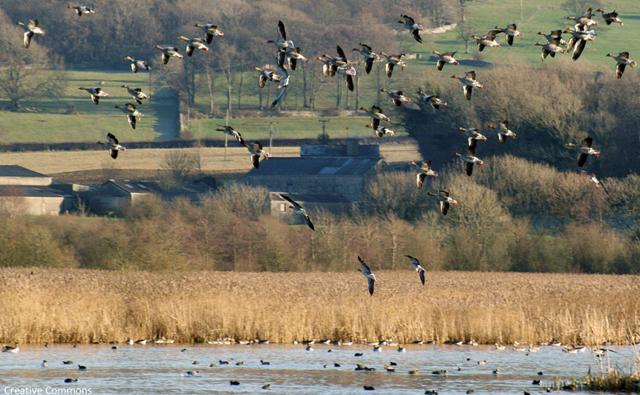 We
decided to escape earlier
this winter on a bright cold December day with our flask and binoculars
packed
and head north. Leighton Moss is situated along the shores of
Morecambe
Bay, as such it is very prone to flooding (the site is closed at the
moment …
if not, guessing you would probably need your waders!) When we visited
a few
years ago this was definitely the case. However on our latest
visit,
although early winter it was a perfect day bright and very sunny ..
wished I’d
worn shades! It was like visiting for the first
time. On arrival we
decided to join the RSPB before climbing to the top of the 9 metre
Skytower
where the view was stunning over the water, part of which was frozen
over. Apparently if you are lucky you can see otters playing.
Winter can
have its own bare beauty, and the sun through the golden reeds at
mid-afternoon
was special. We followed the extensive walking trails .. where robins
and
several varieties of ‘tits’ led the way.
Although the ‘hides’ were not
open I spotted a ‘tree-creeper’ a modest little
bird that carefully hops to
each branch to the top of a high tree. Walking back to the
car a barn owl
solemnly viewed us at a distance. A final unexpected sighting
from the
car park was an early evening performance of a starling murmuration,
which can
take place here between December- March. At just a mile from
Silverdale
shore it’s a lovely spot to watch the sun go down.
The site lies in a
site of Outstanding Natural Beauty, whilst the coastal areas are
designated
Special Areas of Conservation.
We
decided to escape earlier
this winter on a bright cold December day with our flask and binoculars
packed
and head north. Leighton Moss is situated along the shores of
Morecambe
Bay, as such it is very prone to flooding (the site is closed at the
moment …
if not, guessing you would probably need your waders!) When we visited
a few
years ago this was definitely the case. However on our latest
visit,
although early winter it was a perfect day bright and very sunny ..
wished I’d
worn shades! It was like visiting for the first
time. On arrival we
decided to join the RSPB before climbing to the top of the 9 metre
Skytower
where the view was stunning over the water, part of which was frozen
over. Apparently if you are lucky you can see otters playing.
Winter can
have its own bare beauty, and the sun through the golden reeds at
mid-afternoon
was special. We followed the extensive walking trails .. where robins
and
several varieties of ‘tits’ led the way.
Although the ‘hides’ were not
open I spotted a ‘tree-creeper’ a modest little
bird that carefully hops to
each branch to the top of a high tree. Walking back to the
car a barn owl
solemnly viewed us at a distance. A final unexpected sighting
from the
car park was an early evening performance of a starling murmuration,
which can
take place here between December- March. At just a mile from
Silverdale
shore it’s a lovely spot to watch the sun go down.
The site lies in a
site of Outstanding Natural Beauty, whilst the coastal areas are
designated
Special Areas of Conservation.
The
RSPB website, as you would
expect, gives you all the details. https://www.rspb.org.uk
A perfect get-away any time of the year ….
Dunham
Massey – The Winter Garden
 Again
just before the
…... we enjoyed a weekend afternoon visit to
Dunham Massey. Parking
on the road in Dunham town then climbing the stile into the park we
headed off
with a hot drink not quite knowing what was open. We had
passed signs
earlier that the Xmas Lights show was sold out. After so many
months of
quiet and staying home there were lots of families with children and
dogs
safely enjoying the outdoor space.
Again
just before the
…... we enjoyed a weekend afternoon visit to
Dunham Massey. Parking
on the road in Dunham town then climbing the stile into the park we
headed off
with a hot drink not quite knowing what was open. We had
passed signs
earlier that the Xmas Lights show was sold out. After so many
months of
quiet and staying home there were lots of families with children and
dogs
safely enjoying the outdoor space.
Again
we were fortunate the weather
was dry and bright – but you definitely needed winter warm
togs! I have
visited the winter garden in late January a few years ago - which was a
joy
especially in the sun. The bare beauty of the trees, the
emerging
hellebores, cyclamen and spring bulbs are hopeful and welcome but the
real
stars of the show at this time are the winter shrubs. Often
overlooked
later in the year the varieties and warm shocking colours of the Cornus
varieties, Hamamelis (Witch Hazel), Viburnum and the stark white beauty
of the
birch (underplanted with snowdrops soon) are a joy!
The
garden had been turned into
a Xmas Wonderland for early evening visitors (sold out by mid-November)
although free in the daytime – what a treat!
Stunning and imaginative
with colourful but subtle lighting and music – enhancing the
larger trees and
shrubs. A must see for next winter......... but the promise
of spring
bulbs will entice us back – and apparently there is a
bluebell mound in spring
….
Pre-booking
is necessary due to
government guidelines so it is important to check out the current
situation on www.nationaltrust.org.uk
in advance of your
visit. If you are a National Trust member entry and parking
is free but
for non-members there will be a charge.
Angela
Swallow
>>>>>>>>>>
Kew
Gardens in Winter and Lockdown
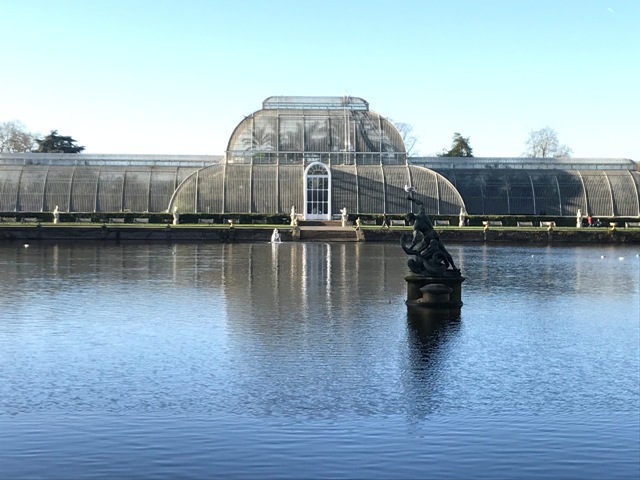 I
am lucky to live very close
to the Royal Botanic Gardens. At present I visit
I
am lucky to live very close
to the Royal Botanic Gardens. At present I visit 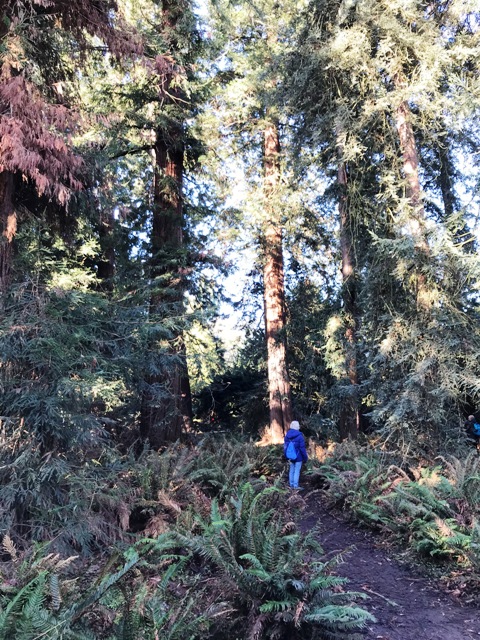 every
day along
with
a fair number of
other people!
every
day along
with
a fair number of
other people!
There
is always plenty for the
gardener to see. Galanthus elwesii var. Monostictus, an early
variety of
snowdrop, has been in flower for weeks. Next to it is a
pretty little
cyclamen coum. In the Broadwalk a large cluster of Helleborus
“Walberton’s
Rosemary” make a lovely show in an otherwise colourless
perennial border.
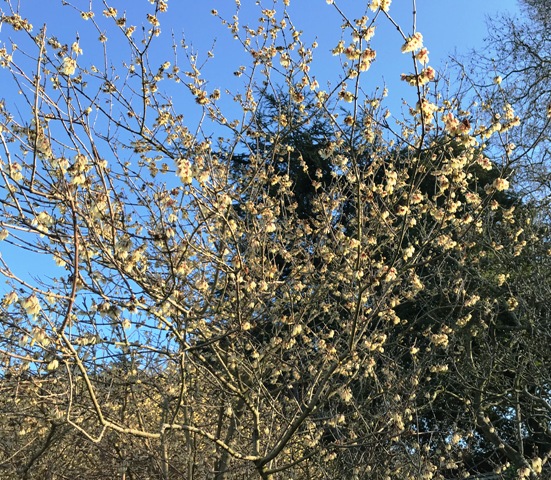 Not
only are there sights to
see but smells to enjoy. The fragrance of Chimonanthus
Praecox
“Grandiflorus” is a delight. Another
aromatic, Hamamelis, witch hazel, is in flower all over the
Gardens. An
information board tells me it was used extensively in Native North
American
medicine. Its anti- inflammatory properties were used to
treat many skin
ailments.
Not
only are there sights to
see but smells to enjoy. The fragrance of Chimonanthus
Praecox
“Grandiflorus” is a delight. Another
aromatic, Hamamelis, witch hazel, is in flower all over the
Gardens. An
information board tells me it was used extensively in Native North
American
medicine. Its anti- inflammatory properties were used to
treat many skin
ailments.
On
the American theme there is
a large group of Coastal Redwoods in the arboretum area of the
Gardens.
These Sequoias sempervirens tower magnificently above visitors. A
wonderful
sight.
As
I look around me I feel so
happy that I know Spring is well on the way.
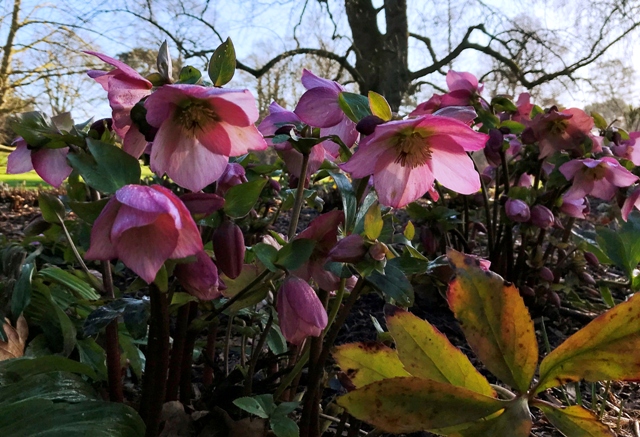
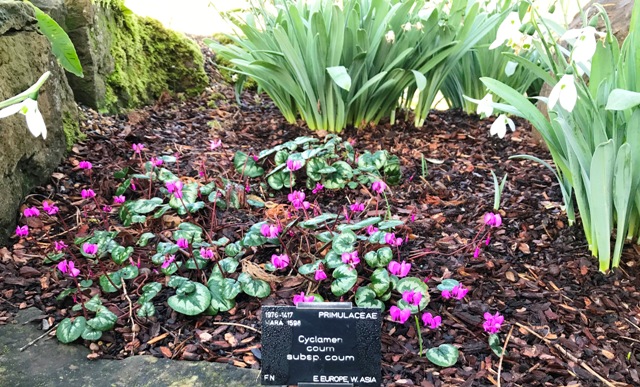
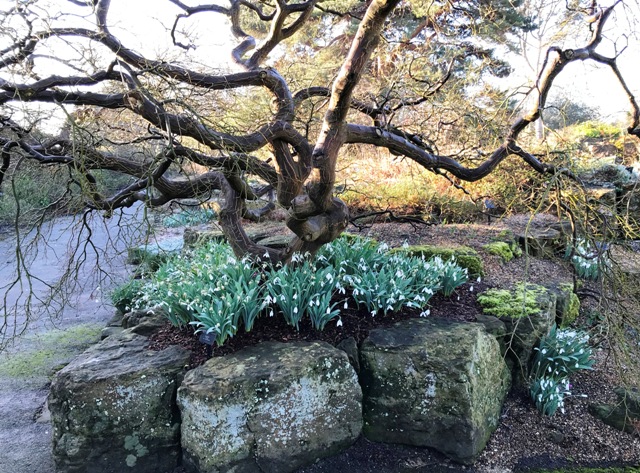
Carole
Woodvine
>>>>>>>>>>
Bird
Seed Cake
Garden
birds are so important
to gardeners, they are a natural pest control and they help with
broadcasting
seeds and with pollination.
We
need to attract them to our
gardens by growing shrubs and plants that provide berries and
seeds in
the wintertime.
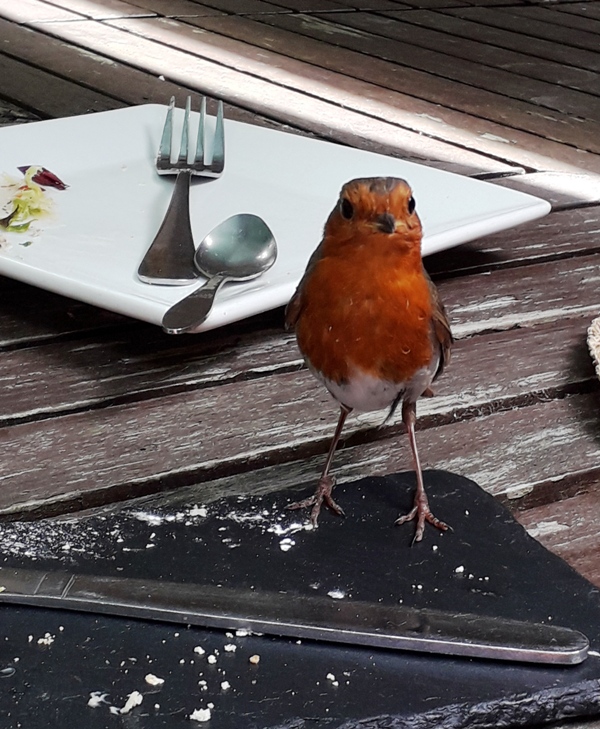 This
photo may not show the
best way to feed them so please read on.
This
photo may not show the
best way to feed them so please read on.
They
have a difficult time in
the winter particularly when the weather is bad, so it is important
that we
help them as much as possible by providing food and water.
When the
temperature drops they need extra food just to keep warm.
Nature doesn’t
always provide enough for their needs when it is very cold so we need
to
supplement their diet with appropriate bird seed, fatballs, mealworms,
dried
fruits, apples, unsalted peanuts etc. Different species
require different
foods.
There
are various bird food
items on the market but it is fun to make your own and children will
love to
help too. How about making bird seed cakes. All you
need is lard
(at room temperature) and a mixture of bird seed and some plastic
straws cut
into 2” pieces.
Rub
together the lard and
birdseed together thoroughly in a large bowl then press the mixture
into
biscuit cutters or patty tins or use your imagination using any shape
as a
mould.
While
the mixture is soft
insert short pieces of plastic straws in the centre. These
create a hole
for string to be threaded through. You just need to put them
into a
fridge to set then they will be ready to hang.
You
might prefer to hang them
individually or use them to create a garland or wreath of several seed
cakes
and hang them on a bush. Another idea is to spread peanut
butter or lard
onto a pinecone then dip the sticky end of the pine cone into bird seed
so it
will stick to the pine cone, leave to set in the fridge then hang that
up
tool A veritable feast mmmmmmmmm.
Another
way to encourage birds
into your garden is to provide nest boxes but be careful where you
place
them. They need to be 2 – 4 metres high on a north
or east facing tree or
wall, this avoids the nest becoming too hot in the sun and also
protects it
from the wettest winds. If you tilt the box forward slightly
rain will
hit the roof and bounce off so keeping the nest dry. Avoid
placing the
nest box on a fence, cats will have easy access.
The
RSPB site mentioned above
will be very useful when all your bird visitors descend on your garden
and you
want to identify them. It is very entertaining to watch their
antics and
helps to dispel the gloom of Lockdown too.
Irene
Spencer
>>>>>>>>>>
DON’T
FORGET